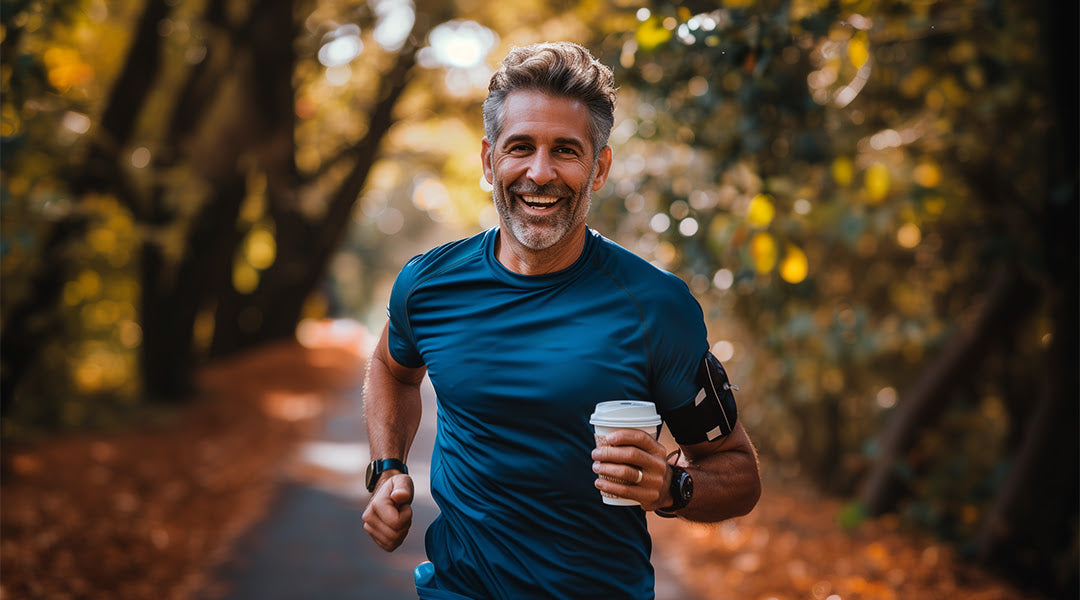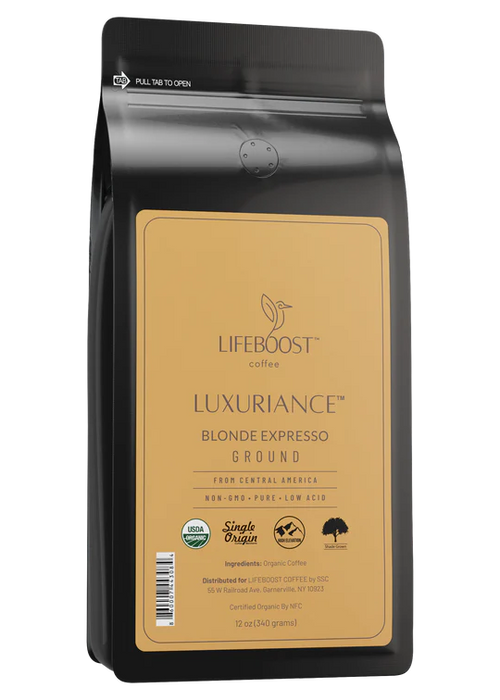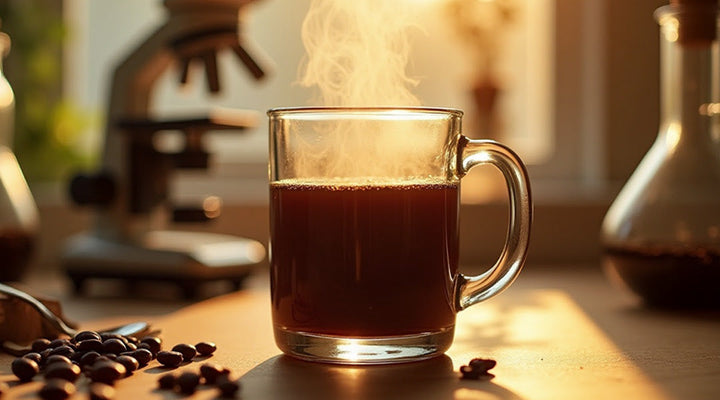
The Health Boosting Benefits Of Movement…And How Coffee Can Help
“40 is the new 30.”
“Navy is the new black.”
These statements can be trendy, informative, or even encouraging (especially for those of us in our 40’s and older).
But, what about this one: “sitting is the new smoking.”
Not so encouraging now, right, though this statement should certainly command our attention.
I’m going to guess that by now every person in America has been educated on the negative health effects of smoking cigarettes.
But, health experts have realized a new threat, one that is just as harmful (as smoking), if not worse.
“Sitting is the new smoking,” is a bold statement put before us by health experts, yet the findings behind such a statement are vitally important.
You see, people were made for movement, yet it seems that we’re moving less and less all the time.
Think about it, most folks sit during their commute to work.
Then, if you have a desk job, that means you’re sedentary for all, or at least most, of your working hours too.
Of course, Netflix binges can be tempting after a long day of work as well, which adds even more hours to the total time in a given day that you’re spending on your tushy.
Even if you spend your evenings outdoors in the spring, summer, and fall months watching your kids or grandkids play sports, it’s likely that you’re sedentary throughout these hours as well.
Sure, I realize the above scenarios can be extreme, given that many folks don’t spend the entire day sitting, but I do believe, if we’d all take an honest inventory of how many hours we spend each day not moving, we may be surprised.
For some perspective, the CDC estimates that Americans spend an average of 6.5-8 hours per day sitting down. And, sitting or lying down for extended periods of time increases your risk of multiple diseases and chronic health problems, both physical and mental.
Overall, this kind of inactivity is now said to be a contributing factor in more than 3 million deaths each year around the world!
Yes, you read that correctly, physical inactivity is a contributing factor in 6% of all deaths worldwide.
But, how?
And, what can you do to ensure you’re not included in that gruesome number?
Let’s find out…
How Does Physical Inactivity Negatively Impact Your Health

Beginning a new exercise routine can be daunting.
Even taking the time to walk around the block each evening after dinner can seem like a chore when you’ve been awake since the wee hours of the morning, had a long day at the office, just helped your kids with their homework, did a few loads of laundry, and made (and cleaned up) dinner.
So yes, it can definitely be tempting, and it certainly is easier, to simply put your feet up and settle in for some couch time instead of getting up and moving your body.
But, skipping those sweat sessions and daily walks can truly wreak havoc on your health.
When you are primarily inactive, spending many hours a day sitting instead of standing and moving, this has multiple negative effects.
When you’re physically inactive:
- You’re prone to being overweight because you burn far fewer calories.
- Over time your metabolism can slow down, making it more difficult for your body to break down fats and sugars, which also contributes to weight gain.
- You don’t use your muscles as much, and this causes them to break down, meaning you’ll lose both strength and endurance.
- The mineral content of your bones decreases making you more prone to injury.
- Hormonal imbalances become more common.
- You may develop poor blood circulation.
- Your immune system won’t function optimally.
- You may have more inflammation throughout your body which contributes to a host of diseases and health problems.
Each of these effects of inactivity and more combine to essentially create a perfect storm.
Then, this storm builds and compounds over time, and before you know it, a number of serious health concerns can arise.
When you are physically inactive, over time you increase your risk of:
- Obesity
- Type 2 diabetes
- Metabolic syndrome
- Osteoporosis
- Heart disease
- Coronary artery disease
- Heart attack
- Stroke
- High blood pressure
- High cholesterol
- Some cancers (specifically breast, colon, and uterine cancers)
- Depression
- Anxiety
As you can see, the negative effects of inactivity not only involve physical health, but even your mental health may be hindered when you frequently skip opportunities to simply get up and move.
So, if you’re already regularly finding ways to exercise, move more, and avoid being sedentary for long periods of time, don’t stop…keep on keeping on!

But, as you’ve taken some inactivity inventory today, if you realize you definitely need to find some ways to get moving, consider the following suggestions:
If you’re seeking to be more active around your house…
- Look at your everyday chores and housework as a means to get moving, and pick up the pace if you want to get your heart pumping even more.
- You don’t necessarily have to skip your favorite Netflix shows when seeking to avoid inactivity. Instead, set a reminder to move every 20-30 minutes while watching TV.
Or, choose to watch your faves while walking on a treadmill or riding a stationary bike, lift weights while catching up on the newest streaming series, or even pull out your yoga mat and plan to get in a session of stretching while watching…you know, incorporating your own, personal, 7th inning stretch!
- Get in some quality family time, involving your entire household in your healthy endeavors, by going for a walk around the block (or your entire neighborhood) after dinner each evening.
If you have children, make a game of this and see how quickly you can all come together to clean up the dinner dishes and get outside for some fresh air and much needed physical activity.
- If you prefer to stay home for all of your exercise needs, seek to find an online workout program you can follow. Or, opt for purchasing in-home workout equipment such as a set of weights, a treadmill, stationary bike, etc.
Just remember, these items to help you get more active at home don’t have to break the bank. The internet is filled with exercise videos, tips, and tutorials, and a yoga mat, medicine ball, small set of weights, jump rope, kettlebells, and/or stretch bands, etc. can all aid in your journey at a minimal cost.
And, if you’re seeking to be more active at work…
- Set a timer to remind yourself to get up and move at least once every hour. Take a few minutes to walk down the hall, grab a glass of water, do a few stretches at your workstation…whatever you need to do to break up the time you normally spend sitting.
- If you spend a lot of time on the phone at work, be sure to stand up while doing so (and move around a bit if you can).
- During set break times or lunch periods, get moving (walking, working out, whatever your allotted time allows).
Then, if you’re looking to begin a new exercise program entirely…
- Remember to start slow.
- Properly evaluate your current physical state, and gradually add more exercise or more movement over time.
- Find the type of exercise that’s right for you. If you begin with an activity that just doesn’t float your boat, don’t give up. Find something you enjoy, find something that’s beneficial, and stick with it.
- Set realistic goals, and consistently work towards those goals.
- Always remember that some exercise is better than no exercise. If you don’t have time for a lot, do a little…just keep moving. Little changes, little movements, these add up and over time, you may find you’ve multiplied your active moments exponentially!
Blonde Espresso
- 20% off
- Free shipping for orders over $50
- Exclusive items available
Take advantage of our limited time offer and save big on your favorite items.
Use Code: LIMITED20
Shop Now
Reap Healthy Rewards When You Get Up And Move

We alluded to this earlier, but just as inactivity has many negative impacts on the health of your body, being active has multiple health-boosting benefits!
1- Helps To Manage Disease
If you have already been diagnosed with serious health concerns or diseases, of course it’s first best to consult with your physician regarding any addition of physical activity, but the simple act of adding exercise to your daily routine can help you manage the effects of many diseases.
From lowering blood sugar levels to aiding in weight loss and boosting energy levels, moving your body can improve the effects of many chronic health conditions.
2- Aids In Disease Prevention
I’m likely stating the obvious here, but for all the health conditions and disease risks that are associated with a lack of physical activity, moving your body can work in the opposite way, serving to prevent disease in most cases.
In the same way that physical activity helps to manage disease, these same aspects can prevent such conditions (by lowering blood pressure, blood sugar, managing weight, reducing risks, etc).
3- Improves Heart Health
Your heart is a muscle, and the more you exercise or engage in physical activity, the stronger this muscle becomes.
Keeping your heart strong and healthy can help you avoid heart disease, improve your blood pressure levels, lower your risk of heart attack and stroke, and simply give you more energy to help you fully enjoy life.
4- Helps You Sleep Better
You need sleep to live. You need quality sleep to be healthy.
When you sleep, your body essentially repairs and regenerates, even removing waste which can build up and accelerate aging and cause disease.
Incorporating regular physical activity is proven to improve your quality of sleep.
In other words, regular exercise means better sleep, and better sleep means better overall health and wellness. Plain and simple.
5- Improves Cognitive Function
A study was done involving the effects of activity on brain function in children, and the results proved just 20 minutes of walking on a treadmill (at only 60% of the participants’ estimated maximum heart rate) enhanced reading comprehension as well as spelling and mathematics performance.
Both anxiety and depression have been linked to poor academic performance, and here we see that something as simple as 20 minutes of physical activity can easily improve these outcomes.
And, of course, this type of benefit doesn’t only apply to children, as physical activity has been proven to decrease symptoms of depression and anxiety as well as lift mood and improve cognitive health as a whole (in adults as well as children).
6- Increases Energy

Many avoid physical activity because they simply feel tired and sluggish. But, when we avoid physical activity, this makes us more tired and more sluggish.
So basically, when we move more, we feel like moving more.
If you want to increase your energy levels, the best thing you can do is incorporate regular exercise.
And, as your energy improves with exercise, it’s also motivating to know that this is happening because that movement is funneling more blood, more oxygen, and more nutrients all throughout your body.
It’s just that simple…you move more, your health improves, your body is functioning more efficiently, and you reap energizing rewards.
7- Helps To Manage Weight
Obesity is one of the leading causes of chronic disease.
Moving more or being more physically active is a great way to aid in weight management, helping you burn more calories, shed excess pounds, and fight disease as you do it.
And, as your weight is better managed, physical activity can also aid in better bone and joint health as well…a win, win, win!
8- Longer Lifespan
As chronic inflammation decreases through regular movement and each of the disease risks associated with inactivity decline, your overall mortality rate improves when you incorporate regular physical activity (avoiding a sedentary lifestyle) as well.
Coffee And Movement

We’ve discussed the health risks of a sedentary lifestyle.
And, we’ve covered the benefits of moving your body.
But, let’s close out our time today looking at a healthy source of both energy and motivation which you can use to fuel just about any activity you seek to incorporate.
And, let me just say, Lifeboosters, you’re in for a treat on this one.
One of the best, healthy, sources to boost your energy levels and even provide motivation to keep you active is none other than coffee!
That’s right - clean, pure, healthy Lifeboost coffee makes the perfect pre-workout, pre-leisurely stroll, pre-movement choice!
No matter whether you’re beginning a new exercise regime, looking to break through a fitness plateau, continuing on your existing course of physical activity, or needing some motivation to simply move more often, coffee is a tried and true fuel source for it all.
Coffee has been thoroughly studied, and the results repeatedly prove this beloved bean to effectively increase mental alertness and physical energy.
When working out, coffee has been shown to help you push harder and work longer, so overall this can make your efforts much more effective.
And personally, I can attest to this!
Prior to drinking Lifeboost, I can’t say I actually enjoyed drinking coffee at all, for reasons regarding flavor and how it made me feel while exercising.
However, as I made the switch to Lifeboost and began mixing our light roast with a clean vanilla protein powder, I not only loved drinking it for the taste, but I absolutely fell in love with how it fueled my runs.
No more jitters, no more stomach issues, no more cutting my workout short because I just felt plain awful.
All of those benefits detailed in the section above? I knew I was fully reaping those rewards when using a clean, healthy coffee to fuel my sweat sessions.
And, it wasn’t long before I found my pre workout coffee routine to be a source of great motivation as well.
Eight ounces of cold brewed Lifeboost light roast, a scoop of vanilla protein powder, a few good shakes, and not only did I enjoy each sip, but I also found I could more easily channel those needed “you’ve got this, you can do this, let’s gooooo” pre workout vibes too.

Overall, during my most active running years I enjoyed this exact fuel (8 ounces, 1 scoop) prior to every training run or workout session, during which I built up to and completed countless 5 and 10K races, 2 official half marathons, one unofficial full marathon (and every run in between).
I suppose you could say I truly ran on Lifeboost.
Of course, I’m not a scientist on a team of researchers proving the effects of coffee as it pertains to physical activity in a lab somewhere, but I can say, personally, with all certainty, that the expert findings are true!
Coffee indeed possesses energy giving powers.
Coffee also provides unexplainable motivation to get up and get moving (especially when routinely incorporated as a pre workout source).
Personally, each time I’d pour, scoop, and shake the contents of my cup, it sparked a drive within me to get up, get going, keep moving, and ultimately reach my goals.
Today, my mode of activity has changed, but I still reach for my tried and true 8 ounces of cold brewed Lifeboost and one scoop of protein powder to fuel every strength training session, stationary bike ride, long walk or jog around the neighborhood, and more.
But, enough about me…what about you?
Many of you rely on the magical powers of coffee to help you rise and shine each morning, but have you considered using your favorite Lifeboost brew to help you make movement a priority as well?
Most energy drinks are filled with ingredients that simply don’t support the health of our bodies. Coffee, on the other hand, can be a clean source of caffeine, providing energy, focus, clarity, and even motivation to help you get up and move.
So, what are you waiting for?
Join us as we commit to sitting less and moving more, and see what a serving of coffee can do to fuel your efforts!
Blonde Espresso
Truly revolutionary coffee. You'll love the taste to the last drop!
Check out Lifeboost Coffee Blonde Espresso.
Medical Disclaimer
This content is for informational and educational purposes only. It is not intended to provide medical advice or to take the place of such advice or treatment from a personal physician. All readers/viewers of this content are advised to consult their doctors or qualified health professionals regarding specific health questions. Neither Dr. Charles Livingston nor the publisher of this content takes responsibility for possible health consequences of any person or persons reading or following the information in this educational content. All viewers of this content, especially those taking prescription or over-the-counter medications, should consult their physicians before beginning any nutrition, supplement or lifestyle program.

Becky is a mother, educator, and content writer for Lifeboost Coffee. She has had three years’ experience as a writer, and in that time she has enjoyed creatively composing articles and ebooks covering the topics of coffee, health and fitness, education, recipes, and relationships.
- https://www.medicalnewstoday.com/articles/sitting-down-all-day#
- https://www.betterhealth.vic.gov.au/health/healthyliving/the-dangers-of-sitting#how-sedentary-are-we
- https://medlineplus.gov/healthrisksofaninactivelifestyle.html
- https://kids.frontiersin.org/articles/10.3389/frym.2023.1068248
- https://www.ncbi.nlm.nih.gov/pmc/articles/PMC2667807/
- https://www.betterhealth.vic.gov.au/health/healthyliving/caffeine
- https://sprc.org/settings/colleges-and-universities/consequences-of-student-mental-health-issues/#
- https://www.who.int/news-room/fact-sheets/detail/physical-activity#
- https://www.betterhealth.vic.gov.au/health/healthyliving/physical-activity-its-important
- https://www.mayoclinic.org/healthy-lifestyle/fitness/in-depth/exercise-and-chronic-disease/art-20046049#
- https://us.humankinetics.com/blogs/excerpt/the-top-10-benefits-of-exercise
- References for the article to confirm data and information.
Drop a Comment
“Great article! Learned a lot about the benefits of movement and coffee for health. Thanks, Lifeboost Coffee!”









